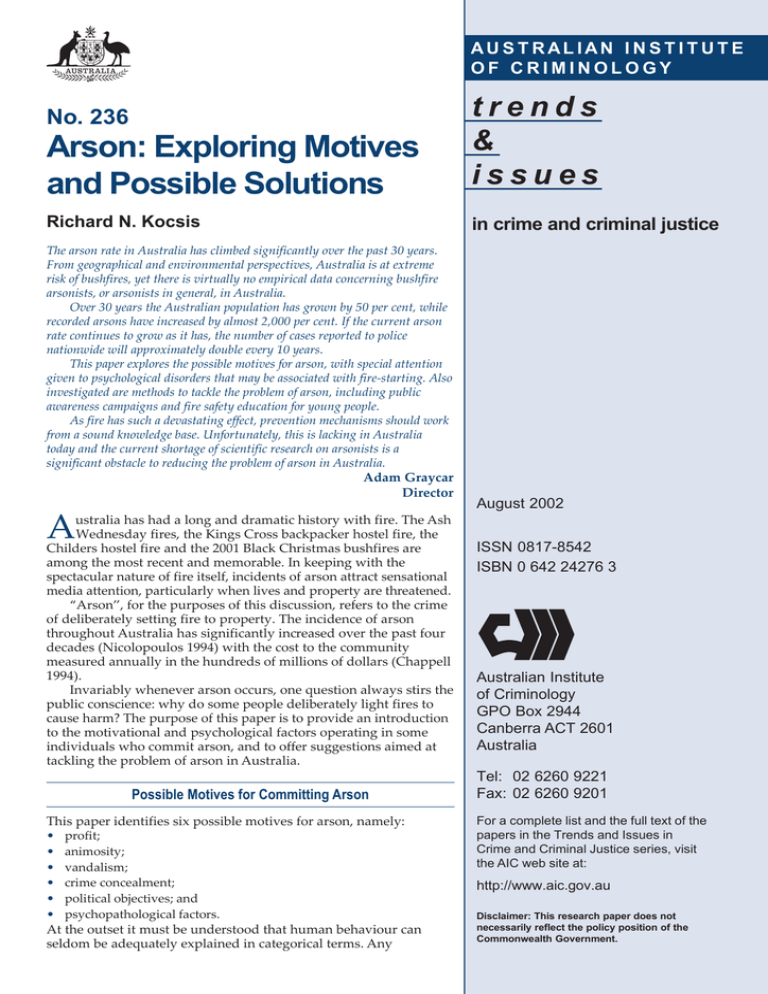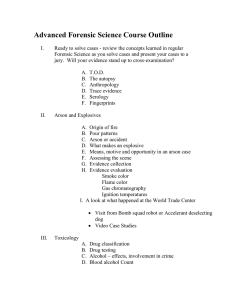Arson : exploring motives and possible solutions
advertisement

AU S T RAL IAN I N S T I T U T E OF CRIMINOLOGY No. 236 Arson: Exploring Motives and Possible Solutions Richard N. Kocsis trends & issues in crime and criminal justice The arson rate in Australia has climbed significantly over the past 30 years. From geographical and environmental perspectives, Australia is at extreme risk of bushfires, yet there is virtually no empirical data concerning bushfire arsonists, or arsonists in general, in Australia. Over 30 years the Australian population has grown by 50 per cent, while recorded arsons have increased by almost 2,000 per cent. If the current arson rate continues to grow as it has, the number of cases reported to police nationwide will approximately double every 10 years. This paper explores the possible motives for arson, with special attention given to psychological disorders that may be associated with fire-starting. Also investigated are methods to tackle the problem of arson, including public awareness campaigns and fire safety education for young people. As fire has such a devastating effect, prevention mechanisms should work from a sound knowledge base. Unfortunately, this is lacking in Australia today and the current shortage of scientific research on arsonists is a significant obstacle to reducing the problem of arson in Australia. Adam Graycar Director A ustralia has had a long and dramatic history with fire. The Ash Wednesday fires, the Kings Cross backpacker hostel fire, the Childers hostel fire and the 2001 Black Christmas bushfires are among the most recent and memorable. In keeping with the spectacular nature of fire itself, incidents of arson attract sensational media attention, particularly when lives and property are threatened. “Arson”, for the purposes of this discussion, refers to the crime of deliberately setting fire to property. The incidence of arson throughout Australia has significantly increased over the past four decades (Nicolopoulos 1994) with the cost to the community measured annually in the hundreds of millions of dollars (Chappell 1994). Invariably whenever arson occurs, one question always stirs the public conscience: why do some people deliberately light fires to cause harm? The purpose of this paper is to provide an introduction to the motivational and psychological factors operating in some individuals who commit arson, and to offer suggestions aimed at tackling the problem of arson in Australia. Possible Motives for Committing Arson This paper identifies six possible motives for arson, namely: • profit; • animosity; • vandalism; • crime concealment; • political objectives; and • psychopathological factors. At the outset it must be understood that human behaviour can seldom be adequately explained in categorical terms. Any August 2002 ISSN 0817-8542 ISBN 0 642 24276 3 Australian Institute of Criminology GPO Box 2944 Canberra ACT 2601 Australia Tel: 02 6260 9221 Fax: 02 6260 9201 For a complete list and the full text of the papers in the Trends and Issues in Crime and Criminal Justice series, visit the AIC web site at: http://www.aic.gov.au Disclaimer: This research paper does not necessarily reflect the policy position of the Commonwealth Government. Australian Institute of Criminology classification of offenders is limited by the often multiple and heterogeneous factors typically operating in any one circumstance (Gold 1962). For example, no discreet entity of “crime concealment” arsonist exists—it is invariably possible to discern other elements operating in the mind of such an offender, such as “animosity” (Prins, Tennent & Trick 1985). Similarly, demographic profiles of the “typical” arsonist can be misleading. Such profiles are often aggregated from samples of apprehended offenders. As the clearance rate for arson is remarkably poor, bias is likely to exist in such samples (Chappell 1994). Nonetheless, a system of classification may serve as a guide for the range of factors possibly in operation. It is in this capacity that the present six motives have been composed, based upon studies of arsonists conducted predominantly in the United States, the United Kingdom and Australia. Profit A profit motive is one where the offender derives some material gain or benefit from setting a fire (Kocsis & Irwin 1997). Thus, monetary needs and desires typically underpin profit motives. The “benefits” inherently connected with profit motive arson typically originate either from a direct or indirect link with the offender. A distinguishing feature of direct profit motive is that the offender is also a pseudo-victim and holds some interest in the destroyed property. An example of arson motivated by direct profit is where an owner (or agent) burns an unsuccessful business premise to collect on insurance. The benefits derived from a direct profit motive do not necessarily involve only fraudulent insurance claims. The destruction of a heritage-listed structure to circumvent development restrictions (Brady 1982), or the destruction of a public house by its occupant in the hope of being relocated to better accommodation, are also examples of direct profit motives. With an indirect profit motive, some benefit through the destruction of property is achieved but the offender does not typically hold any interest in the destroyed property. An illustration of this scenario is where, for example, two rival businesses exist. The owner of one business may set out to destroy a competing business and through its destruction achieve a benefit in the form of reduced competition. Indirect profit motives are not necessarily confined to scenarios involving rivalry. Other examples may include: • a farmer who burns neighbouring bushland in order to destroy “pest” fauna; • a fire lit by an on-call firefighter who is paid only when responding to a fire; or • a janitor who lights a fire at work to incur overtime pay in cleaning up after it. Animosity Crimes committed due to feelings of anger, hatred or revenge are not unique or intrinsic to arson. However, such sentiments often find expression in fire-setting. Indeed, some motivational element of anger is believed to underpin a high proportion of all arson crimes (Rix 1994). Instead of an offender physically assaulting an individual with whom he or she has a grievance, the offender may attack the victim (or their property) and use fire as their weapon. Examples of fires motivated by such acrimonious sentiments are almost endless and can include feuds between neighbours, former friends and even spurned lovers. This motivational concept is often labelled as a “revenge” category; however, this title is somewhat of a misnomer as it does not adequately describe all of the psychological factors potentially in operation. The term revenge denotes a retaliatory relationship where there is some link between the victim and offender. There can be 2 circumstances of arson precipitated by sentiments of anger or rage that do not necessarily involve a retaliatory link between the offender and the actual target. A foundational tenet of human psychology is the concept of displacement, where feelings such as anger find expression in unrelated objects (Blackburn 1993). An example of displacement with respect to arson may occur when a disagreement develops between an employee and a supervisor. The employee may refrain from directly attacking the supervisor to avoid repercussions but, as an outlet for his or her anger, may set fire to public space (such as nearby bushland). Consequently, the broader descriptor of animosity is adopted here to encompass the range of psychological mechanisms that are associated with this motivational drive. Vandalism Vandalism is the malicious and wanton destruction of property (Kocsis & Irwin 1997) and, as with the animosity category, is not in any way intrinsic to arson. It is, rather, a phenomenon common to juvenile delinquency that sometimes manifests itself in firesetting behaviour. An example might involve a group of juveniles who instead of scrawling graffiti on a bus stop enclosure, attempt to burn it instead. Fires instigated by motives of vandalism are possibly the hardest to comprehend given their seemingly purposeless nature. Unlike many other motives, there is typically no coherent reason for why these fires are started beyond an apparent disregard for the rights of others, a mischievous mindset, possible peer group pressure, boredom or a mixture of all of these factors. Crime Concealment As the title implies, this motive is perpetrated with the intent of concealing or, more specifically, destroying evidence pertaining to Australian Institute of Criminology the commission of another crime (Rix 1994). This motive is somewhat unique because arson here is a secondary outcome to a primary goal. One example could be the destruction of a stolen vehicle by a thief to destroy fingerprints and DNA evidence. In this case the primary goal of the offender is theft, not arson. The need to commit arson is only a means by which the offender hopes to conceal or destroy evidence of the original crime. Political Objectives Arson can also be committed in pursuit of a political goal (Scott 1974). Once again, arson motivated by political considerations provides an example of fire being used as a conduit to express some other sentiment. In this context, fire is used to signify extreme and violent protest. There are numerous examples of arson motivated by political objectives and they can include: • acts of terrorism, such as the firebombing of an abortion clinic by religious extremists (Pike 1972); • racial discrimination of a family who have moved to a new suburb; or • civil disturbance due to social and/or racial tensions (Georges 1975). Psychopathological Factors Public perceptions of arsonists are sometimes synonymous with individuals suffering from a mental disorder (Kapardis, Rawson & Antonopoulos 1983). Such perceptions seem to be reinforced by the poor understanding and overgeneralisation of psychological disorders such as pyromania (Geller, McDermeit & Brown 1997). As discussed earlier, there are numerous reasons to explain the possible motives behind arson, none of which are specifically related or necessarily precipitated by mental disorder. Indeed, it is quite difficult to establish the actual frequency of mental disorder within individuals who commit arson. Some studies have found the frequency to be as low as 10 per cent (United States Department of Justice 1982) while others claim it is over 60 per cent (Taylor & Gunn 1984). Such disparities are likely to be artefacts of the samples studied, as well as the proclivities of mental health practitioners to apply various diagnostic labels and definitions to explain criminal behaviour (Foucault 1978). The mere presence of mental disorder within an individual does not automatically equate to it being the cause of fire-setting behaviour. For example, a failing business burnt down by an owner who has an intermittent history of schizophrenia could be more closely connected to poor returns on the business, rather than the mental disorder, and thus motivated by profit. Describing Possible Psychopathological Factors Empirical examinations of arsonists who have been referred to psychiatric hospitals have generally found that schizophrenia, personality disorders, various forms of mental handicap, substance abuse, and mood disorders are the most frequent diagnoses (Koson & Dvoskin 1982). Each of these, and the concept of pyromania, are briefly discussed below. Schizophrenia Schizophrenia is a debilitating mental disorder where an individual can suffer from a range of symptoms, the most notable being delusions and hallucinations. These can impair the individual’s ability to comprehend the true nature and circumstances of his or her environment. An example in the context of arson may be an individual suffering from paranoid delusions of persecution who sets a nearby house alight in the belief that government surveillance equipment has been monitoring them. In reality no such surveillance or equipment actually exists. 3 Personality Disorders A personality disorder is an enduring pattern of inner experience and behaviour that deviates from the expectations of the individual’s culture, is pervasive and inflexible, has an onset in adolescence, is stable over time and leads to distress or impairment (American Psychiatric Association 2000). There are a variety of personality disorders but the most pertinent is possibly the Antisocial Personality Disorder (formerly known as “psychopathy”). Antisocial Personality Disorder is characterised by a pattern of disregard for, and violation of, the rights of others (American Psychiatric Association 2000). An example in the context of arson may be an individual who suffers a very minor affront owing to poor service from a sales assistant who, rather than simply dismissing such a trivial incident as most people would do, instead returns to the shop later to light a fire in retaliation for this affront. Another relevant personality disorder is the Histrionic Personality Disorder. This is typically characterised by a pattern of excessive emotionality and attention-seeking (American Psychiatric Association 2000). An example of an arsonist with such traits may be someone who deliberately lights a fire, raises the alarm and may even seek to inject themselves into the action by heroically attempting to extinguish the fire. Mental Handicap Mental handicap, for the purposes of this paper, refers to mental impairment of some physical or neurological origin. Individuals with these impairments do not necessarily possess any inherent proclivity to lighting fires per se, but may have reduced cognitive functions that can render them more impulsive, suggestible or unable to appreciate the consequences of their actions (Shea 2002). These diminished cognitive functions, when Australian Institute of Criminology combined with contextual factors, may lead to fire-setting behaviour. Substance Abuse The consumption of drugs and alcohol in excessive quantities has a disinhibiting effect upon the normal controls of human behaviour. Thus, intoxicating substances can act as facilitators to antisocial acts (such as arson) which an individual in a state of sobriety may not normally indulge in. Mood Disorders Mood disorders represent another major category of mental disease and include conditions such as depression and bi-polar disorder. As the name implies, mood disorders describe significant aberrations in human affect or mood. Consequently, an individual suffering from severe depression may seek to suicide by setting fire to their home. Pyromania Although pyromania is probably the most infamous psychological disorder associated with firesetting, considerable debate has transpired since the 1850s on what pyromania is, and whether such a discrete psychological entity truly exists (Geller 1992). Some authors associate the term with fire-setting for the pleasure of observing flames (Vreeland & Lewin 1980), whereas others use it to describe those motivated by an irresistible impulse to light fires (Lester 1975). Fire-setting has also been associated with sexual satisfaction (Prins 1980). Each of these conceptions of pyromania could also be interpreted within more generic diagnostic classifications of obsession, compulsion or sexual perversion. More recently, Shea (2002) has observed that the application of the DSM-IV (the American Psychiatric Association’s diagnostic guide for mental diseases) criteria for pyromania has evolved into a default category which is used only when fire-setting behaviour cannot be explained by other motives or psychological factors. Consequently, there appears to be little consensus concerning this popular yet elusive term (Geller 1992). Possibly the only point of consensus is that the occurrence of pyromania is extremely rare, which again highlights the question of whether such a discrete disorder genuinely exists. are often ignited by children owing to their ignorance about the fire’s capacity to spread and of the real dangers it can pose, rather than any genuine malevolent intent (Gaynor & Hatcher 1987). Solutions for the Future: Therapy, Prevention or Punishment? Children as Arsonists Although individuals from virtually any age group can commit arson, very young children often light fires. It must be recognised that playing with matches, lighters and fire is a common feature of children’s play. Indeed, a number of studies have examined large samples of clinically “normal” children and have found that up to 60 per cent expressed an interest in fire, or had previously played with fire on a number of occasions (Kafry 1980). The onset of such interest or actual fire play by children is believed to occur as early as three years of age (Block & Block 1975). Unfortunately, no definitive theory currently exists to explain the origin of this phenomenon. One possible explanation stems from the general notion of fire’s primordial fascination to the human psyche. Thus, in the same way that folklore, technology and even entertainment sometimes involve fire as a theme or element, this same inherent fascination seems to manifest itself in the fire play commonly observed among young children (Gaynor & Hatcher 1987). As Shea (2002) observes, young children are naturally curious and the ignition of a fire presents an exciting prospect for some. At the same time, young children do not possess a substantial amount of knowledge or experience concerning the dangers of fire. Once they acquire such knowledge and experience, often through maturity and education, they also frequently develop foresight that may encourage them to exercise caution when lighting fires. Fires 4 It is important to understand that there is no one solution for solving the problem of arson. Arson is a crime that can be motivated by a multitude of sometimes heterogeneous factors. Whereas penalties such as fines and imprisonment for offenders who commit arson primarily for profit may seem appropriate, there are other arsonists (for example, the very young or those who suffer from mental disease) for whom professional care, therapy or education may be in order. At the height of the 2001 Black Christmas bushfires in New South Wales, public outcry via talk-back radio spawned a number of suggestions to deter or punish arsonists. Possibly the most absurd suggestion was to inflict burns on apprehended arsonists. Putting aside the many legal and ethical issues surrounding this proposition, such action would be unlikely to have a deterrent effect: even the most extreme form of punishment (that is, the death penalty) has been found to have little effect in genuinely deterring the commission of crimes such as homicide (Walker 1992). The guiding philosophy underpinning this proposition appears to be one of retribution rather than a serious attempt to address the issue of prevention. Another proposition involved the introduction of stiffer penalties, including increased gaol terms. While this is a predictable response to crime problems generally, it is unlikely to serve as a deterrent primarily because it is a notion premised on the idea that all arsonists engage in rational thought before Australian Institute of Criminology embarking upon a crime; that is, having considered the dire consequences, potential offenders will presumably refrain from indulging in criminal behaviour. As can be seen by the factors previously discussed, such contemplation does not always occur and, indeed, is sometimes not capable of occurring. Very young children—who represent one of the highest proportions of offenders actually apprehended— will often not have the mental maturity to understand their deeds. Similarly, individuals with mental impairment or those suffering from delusional states will have little comprehension of their actions and, more specifically, of the consequences. Other suggestions floated during this time included the creation of a specialised arsonist registry and the development of a community service program where offenders would be confronted with the damaging effects of their fires and would be forced to repair the damage. The exact purpose of such an arsonist registry, or what it may seek to accomplish, was not articulated. The simple creation of a record of apprehended arsonists appears, however, to be an unnecessary exercise—such a registry arguably exists already in the form of criminal records kept by police departments throughout Australia. Assuming that such a registry were to function by publicly identifying offenders, numerous problems are likely to be encountered. Not only with respect to privacy concerns and protections, but perhaps more importantly by stigmatising and preventing the rehabilitation and integration of offenders who would otherwise stand a chance of changing their ways. For example, it is likely to cause more harm than good to place young children on such a registry; to do so would effectively label them as delinquent or deviant, which may in turn perpetuate similar or escalated behaviour encouraged by self-identification with such a label. Thus, antisocial behaviour could continue into adulthood even though the offending behaviour of one’s youth may, with maturity, have passed without further incident. It is not immediately apparent how showing arsonists the consequential damage of their actions would be of practical benefit to these individuals or others. For example, individuals motivated by animosity or some political objective may view this as an opportunity to revel in their actions. Suggestions Public awareness campaigns to highlight the extent and cost of arson to the community may assist in encouraging members of the public to be more proactive and alert to possible scenarios of arson in much the same way that drink-driving campaigns have influenced community behaviour over time. A number of fire brigade organisations currently operate educational programs aimed at teaching youngsters about the dangers of lighting fires. For example, the JAFFA (Juvenile and Family Fire Awareness) program in Western Australia attempts to reduce the risk of fire play by intervening when children display inappropriate behaviour with fire. Certainly, younger members of the community, such as primary school-aged children, might benefit the most from such programs. There are dangers, however, in some forms of publicity. For example, by publicising the heroic deeds of firefighters, some wouldbe fire-setters with histrionic personality traits may be inspired to join fire brigades with the idea of participating in the action. On occasion, firefighters are retrospectively identified as being arsonists. Although firefighting organisations often dismiss such incidents as extremely rare, they are nonetheless repeatedly documented, suggesting their frequency may not be as low as hoped (Douglas et al. 1992; Lewis & Yarnell 1951; Prins 1994; Scott 1974). 5 Consequently, some serious consideration should be given to the degree of psychological screening adopted when recruiting personnel for firefighting organisations. Although measures currently exist in regular fire brigades that retain paid staff, volunteer organisations may be more reticent to adopt intensive screening procedures as that might reduce the pool of suitable applicants. Similarly, potential volunteers may regard it as unduly onerous in light of their services being offered gratis. Firefighting organisations that retain paid staff may be well advised to avoid the policy of paying according to the number of fires attended, as such a practice has the potential to encourage acts of arson. One of the greatest barriers to the effective investigation of arson is that it is a technically difficult crime to detect and solve. As a consequence, a generic level of training provided to police detectives will not always prove adequate for the investigation of these crimes (Dehaan 1991). One possible solution is to ensure that a greater proportion of police personnel undergo specialist training in the investigation of arson. This would not necessarily involve an increase in police numbers in an attempt to reduce arson, nor is this a suggestion for intensive training for only a select number of police personnel, or for the formation of elite specialist units which may foster unhealthy insular practices (Wood 1997). Along with improved training, new strategies to assist in the investigation of arson should be explored. Continued development in the forensic sciences to identify arson from accidental or naturally occurring fires is clearly warranted. One example may be the greater use of sniffer dogs to aid in the detection of accelerants used in arson crime scenes (Sarzin 2002). Similarly, the continued development of profiling techniques may prove Australian Institute of Criminology useful—a recent study found profiling to be helpful in the investigation of serial arson crimes (Kocsis and Irwin 1997; Kocsis, Irwin & Hayes 1998; Kocsis in press; Kocsis & Cooksey in press). Perhaps the single most effective way of addressing the problem of arson is to enhance our understanding of this type of crime. In the course of writing this paper, the paucity of scientifically rigorous research into bushfire arsonists (or arsonists generally) within Australia, was strikingly apparent. Given the topology and geography of Australia, which is characterised by a hot, dry climate with large tracts of bushland, it is surprising that research into this crime is not given far greater priority. Only through rigorous research into the phenomenon of arson can policies and proposed solutions stand a chance of effectively combating the problem. References American Psychiatric Association 2000, Diagnostic and Statistical Manual of Mental Disorders, Fourth Edition— Text Revision, American Psychiatric Association, Washington DC. Blackburn, R. 1993, The Psychology of Criminal Conduct, John Wiley & Sons, Liverpool. Block, J.H. & Block, J. 1975, Fire and Children: A Study of Attitudes, Behaviours and Maternal Teaching Strategies, Technical Report for Pacific South-Western Forest and Range Services, United States Department of Agriculture. Brady, J.P. 1982, “Arson, fiscal crisis, and community action”, Crime and Delinquency, vol. 28, pp. 247–70. Chappell, D. 1994, “Opening address”, Focus on the Arsonist and Arson Prevention National Workshop, hosted by the Australian Institute of Criminology, Goulburn, 25– 26 February. Dehaan, J.D. 1991, Kirks Fire Investigation, third edition, Prentice Hall, Englewood Cliffs, New Jersey. Douglas, J.E., Burgess, A.W., Burgess, A.G. & Ressler, R.K. 1992, Crime Classification Manual, Lexington Books, New York. Foucault, M. 1978, “About the concept of the dangerous individual in nineteenth century legal psychiatry”, International Journal of Law and Psychiatry, vol. 1, pp. 1–18. Gaynor, J. & Hatcher, C. 1987, The Psychology of Child Firesetting, Brunner/Mazel Inc., New York. Geller, J.L. 1992, “Arson in review: From profit to pathology”, Clinical Forensic Psychiatry, vol. 15, pp. 623–45. Geller, J.L., McDermeit, M. & Brown, JM. 1997, “Pyromania: What does it mean?” Journal of Forensic Science, vol. 42, no. 6, pp. 1,052–7. Georges, D.E. 1975, “Ecology of urban unrest: The case of arson— Newark, New Jersey, July 1967”, Journal of Environmental Systems, vol. 5, pp. 203–28. Gold, J.H. 1962, “Psychiatric profile of the firesetter”, Journal of Forensic Science, vol. 7, pp. 203–28. Kafrey, D. 1980, “Playing with matches: Children and fires”, in D. Canter (ed.), Fires and Human Behaviour, John Wiley, Chichester, pp. 47–62. Kapardis, A., Rawson, R. & Antonopoulos, N. 1983, “Research note: Man-caused forest fires in Victoria”, Australian and New Zealand Journal of Criminology, vol. 16, pp. 244–7. Kocsis, R.N. (in press), “Psychological profiling in serial arson offences: A comparative assessment of skills and accuracy”, Criminal Justice and Behaviour. Kocsis, R.N. & Cooksey, R.W. 2002, “Criminal psychological profiling of serial arsonists”, International Journal of Offender Therapy and Comparative Criminology, vol. 46, no. 4, pp. 631–56. Kocsis, R.N. & Irwin, H.J. 1997, “An analysis of spatial patterns in serial rape, arson and burglary: The utility of the circle theory of environmental range for psychological profiling”, Psychiatry, Psychology and Law, vol. 4, pp. 195–206. Kocsis, R.N., Irwin, H.J. & Hayes, A.F. 1998, “Organised and disorganised behaviour syndromes in arsonists: A validation study of a psychological profiling concept”, Psychiatry, Psychology and Law, vol. 5, pp. 117–30. Koson, D.F. & Dvoskin, J. 1982, “Arson: A diagnostic study”, Bulletin of the American Academy of Psychiatry and Law, vol. 10, pp. 39–49. Lester, D. 1975, “Firesetting”, Corrective and Social Psychiatry, vol. 21, pp. 22–6. Lewis, N.D.C. & Yarnell, H. 1951, Pathological Fire-Setting, Coolidge Foundations, New York. 6 Nicolopoulos, N. 1994, Incendiary and Suspicious Fires 1987–1993, statistical research paper, New South Wales Fire Brigades, Sydney. Pike, E.A. 1972, Protection against Bombs and Incendiaries, CC Thomas, Springfield, Illinois. Prins, H. 1980, Offenders, Deviants or Patients? Tavistock Publications, London, pp. 195–212. —— 1994, Fire-raising: Its Motivation and Management, Routledge, London. Prins, H., Tennent, G. & Trick, K. 1985, “Motives for arson (fire raising)”, Medicine, Science and the Law, vol. 25, no. 4, pp. 275–8. Rix, K.J.B. 1994, “A psychiatric study of adult arsonists”, Medicine, Science and the Law, vol. 34, no. 1, pp. 21–34. Sarzin, A. 2002, “Sniffing out arsonists”, NSW Police News, vol. 82, no. 5, p. 37. Scott, D. 1974, Fire and Fire-Raisers, Duckworth, London. Shea, P. 2002, “The lighting of fires in a bushland setting”, Judicial Officers’ Bulletin, vol. 14, no. 1, pp. 1–5. Taylor, P.J. & Gunn, J. 1984, “Violence and psychosis”, British Medical Journal, vol. 228, pp. 1,945–9. United States Department of Justice 1982, Uniform Crime Report for the United States, Federal Bureau of Investigation, United States Department of Justice, Washington DC. Vreeland, R.G. & Lewin, B.M. 1980, “Psychological aspects of firesetting”, in D. Canter. (ed.), Fires and Human Behaviour, John Wiley, Chichester, pp. 31–46. Walker, J. 1992, “Homicides and the death penalty in Australia—1915– 1975”, Criminology Australia, vol. 3, no. 3, January/February, pp. 19–25. Wood, J.R.T. 1997, Final Report, Royal Commission into the New South Wales Police Service, Sydney. Dr Richard N. Kocsis is a forensic psychologist in private practice in Sydney. He may be contacted by email at: richard_kocsis@hotmail.com. General Editor, Trends and Issues in Crime and Criminal Justice series: Dr Adam Graycar, Director Australian Institute of Criminology GPO Box 2944 Canberra ACT 2601 Australia Note: Trends and Issues in Crime and Criminal Justice are refereed papers.





